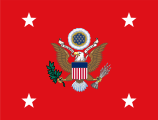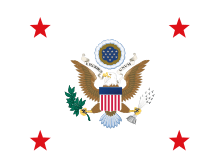Simon Cameron
| Simon Cameron | |
|---|---|
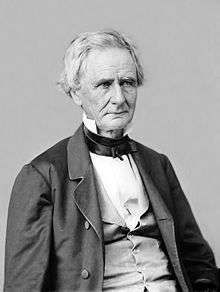 | |
| United States Senator from Pennsylvania | |
|
In office March 4, 1867 – March 12, 1877 | |
| Preceded by | Edgar Cowan |
| Succeeded by | J. Donald Cameron |
|
In office March 4, 1857 – March 4, 1861 | |
| Preceded by | Richard Brodhead |
| Succeeded by | David Wilmot |
|
In office March 13, 1845 – March 3, 1849 | |
| Preceded by | James Buchanan |
| Succeeded by | James Cooper |
| United States Minister to Russia | |
|
In office June 25, 1862 – September 18, 1862 | |
| President | Abraham Lincoln |
| Preceded by | Cassius Clay |
| Succeeded by | Cassius Clay |
| 26th United States Secretary of War | |
|
In office March 5, 1861 – January 14, 1862 | |
| President | Abraham Lincoln |
| Preceded by | Joseph Holt |
| Succeeded by | Edwin Stanton |
| Personal details | |
| Born |
March 8, 1799 Maytown, Pennsylvania, U.S. |
| Died |
June 26, 1889 (aged 90) Maytown, Pennsylvania, U.S. |
| Political party |
Democratic (Before 1849) American (1849–1856) Republican (1856–1877) |
| Spouse(s) | Margaret Brua |
| Signature |
|
Simon Cameron (March 8, 1799 – June 26, 1889) was an influential American businessman and politician who served as United States Secretary of War for Abraham Lincoln at the start of the American Civil War.
Cameron made his fortune in railways, canals and banking, and founded the Bank of Middletown.[1] He then turned to a life of politics. He became a U.S. senator in 1845 for the state of Pennsylvania, succeeding James Buchanan. Originally a Democrat, he failed to secure a nomination for senator from the Know-Nothing party, and joined the People's Party, the Pennsylvania branch of what became the Republican Party. He won the Senate seat in 1857, and became one of the candidates for the Republican nomination in the presidential election of 1860.
Cameron gave his support to Abraham Lincoln, and became his Secretary of War. He served only a year before resigning amidst allegations of disorganization and corruption during the early phases of the American Civil War. Cameron then became the minister to Russia, but was overseas for less than a year.
Beginning in 1867, he again served in the Senate; he was succeeded by his son, J. Donald Cameron in 1877, and only resigned upon confirmation that his son would succeed him. After leaving the Senate, Cameron lived in retirement, but still participated in politics and tended to his many business interests. He died in 1889 and was buried in Harrisburg.
Cameron's chief legacy was a powerful Republican party machine that continued to dominate Pennsylvania politics long after his death.
Early life
Simon Cameron was born in Maytown, Pennsylvania in 1799,[1] to Charles Cameron (d. 16 January 1814), son of Simon Cameron and Martha Pfoutz (1771-1830)[2] (daughter of Conrad Pfoutz / Foutz (1734 - 20 November 1808)[3], a ranger during the American Revolution,[4][5] and Elizabeth Cameron (1733-1827)), and his wife Martha McLaughlin (d. abt. 10 Nov 1830), daughter of Hugh McLaughlin.[6]
But the above personal information does not match the story that he was orphaned at nine and later apprenticed to a printer, Andrew Kennedy, editor of the Northumberland Gazette before entering the field of journalism. It may be that he was apprenticed to Kennedy at age nine (~1808) for a then standard period of seven years, and continued as a journeyman printer at age 16 (~1815). He was the third of five sons; they had three younger sisters.[6]
He was editor of the Bucks County Messenger in 1821. A year later, he moved to Washington, D.C., and studied political movements while working for the printing firm of Gales and Seaton. On 17 October 1822 in Harrisburg, Pennsylvania, Cameron married Margaret Brua (1794-1875),[7] daughter of Peter Brua (19 Feb 1771 – 1 Jan 1842) and Catherine Rupley (1777 – 19 Jan 1832),[8] the daughter of Johann Jacob Rupple alias Lieut. Jacob Rupley.[9][10] Cameron purchased and ran the Harrisburg Republican in 1824.
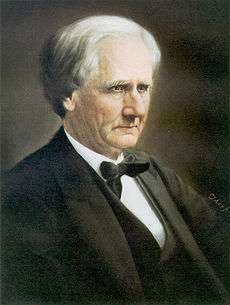
Cameron served as state printer of Pennsylvania from 1825 until 1827, and was state adjutant general in 1826. He constructed several rail lines and merged them into the Northern Central Railway. He founded the Bank of Middletown in 1832 and engaged in other business enterprises. In 1838, he was appointed as commissioner to settle claims of the Winnebago Indians.
Politics
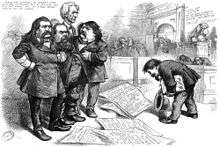
Cameron began his political career as a Democrat, supporting the campaigns of Andrew Jackson and Martin Van Buren.[11] He was elected to replace James Buchanan in the United States Senate in 1845, serving until 1849.[1] A persistent opponent of slavery, Cameron switched to the Know Nothing Party, before joining the Republican Party in 1856.[12] In 1857, Cameron was again elected to the US Senate.[1]
At the 1860 Republican National Convention, Cameron controlled the votes of the Pennsylvania delegation. He delivered those votes to Abraham Lincoln for the nomination for President, which was decisive. In return, Lincoln's managers promised a Cabinet post for Cameron. When Lincoln became President, he reluctantly appointed Cameron Secretary of War. His tenure was marked by allegations of corruption and lax management, and he was forced to resign early in 1862. His corruption was so notorious that US Representative Thaddeus Stevens (also from Pennsylvania), when asked whether Cameron would steal, said "I don't think that he would steal a red hot stove."[1] (Cameron demanded Stevens retract this insult. Stevens said to Lincoln "I believe I told you he would not steal a red-hot stove. I will now take that back.") Cameron was succeeded as Secretary of War by Edwin Stanton, who had been serving as Cameron's legal advisor. Cameron then served as Minister to Russia.[1]
Cameron's brother, James Cameron, colonel of the 79th New York Volunteer Infantry Regiment, was killed in action at the First Battle of Bull Run on July 21, 1861.
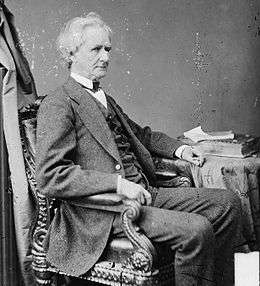
Cameron made a political comeback after the Civil War, building a powerful state party machine that would dominate Pennsylvania politics for the next seventy years.[12] In 1866, Cameron was again elected to the Senate. Cameron convinced his close friend Ulysses S. Grant to appoint his son, James Donald Cameron, as Secretary of War in 1876.[12] Later that year, Cameron helped Rutherford B. Hayes win the Republican nomination in 1876.[12] Cameron resigned from the Senate in 1877 after assuring that his son would succeed him. Though Cameron had intended for his son to succeed him as head of the state machine, Matthew Quay ultimately succeeded Cameron as the party boss.[13]
Later life
Cameron retired to his farm at Donegal Springs Cameron Estate near Maytown, Pennsylvania where he died on June 26, 1889.[1] He is buried in the Harrisburg Cemetery in Harrisburg, Pennsylvania.[1] Cameron County, Pennsylvania, and Cameron Parish, Louisiana, are named in his honor.
See also
- Simon Cameron House and Bank, Middletown, Pennsylvania
- Simon Cameron House, Harrisburg, Pennsylvania
- Simon Cameron School, Harrisburg, Pennsylvania
References
- 1 2 3 4 5 6 7 8 "Cameron, Fritchie are luminaries of era". Intelligencer Journal. 2011-02-07. Retrieved 2016-11-11.
- ↑ Martha Foutz, in North America Family Histories, accessed February 2018.
- ↑ Find-a-Grave: Conrad Foutz, accessed February 2018.
- ↑ Wikitree: Conrad Foutz, accessed February 2018.
- ↑ Conrad Foutz of the Lancaster County Militia, Seventh Battalion, second class, under Capt. McKee, 1781; SAR Application, citing Pennsylvania Archives Fifth Series, Vol. VII, page 732.
- 1 2 Lancaster, Pennsylvania, Mennonite Vital Records, 1750-2014 for Charles Cameron, accessed February 2018.
- ↑ Marriage of Simon Cameron and Margareth Brua; Historical Society of Pennsylvania; Philadelphia, Pennsylvania; Historic Pennsylvania Church and Town Records; Reel: 691, via ancestry.com paid subscription site accessed February 2018.
- ↑ Find-a-Grave: Catherine Rupley Brua, accessed February 2018.
- ↑ Margaretta Brua, in the U.S., Sons of the American Revolution Membership Applications, accessed via ancestry.com paid subscription site in February 2018.
- ↑ Find-a-Grave: Johan Jacob Rupple, accessed February 2018.
- ↑ "Simon Cameron". Tulane.edu. Tulane. Retrieved 25 November 2014.
- 1 2 3 4 "Simon Cameron Historical Marker". Explore PA History.com. WITF. Retrieved 25 November 2014.
- ↑ Blair, William Alan (April 1989). "A Practical Politician: The Boss Tactics of William Stanley Quay". Pennsylvania History. 56 (2): 78–89.
Further reading
- Bradley, Erwin Stanley (1966). Simon Cameron, Lincoln's Secretary of War: A Political Biography. Philadelphia, Pennsylvania: University of Pennsylvania Press. LCCN 65020756.
- Crippen, Lee Forbes (1942). Simon Cameron, Ante-Bellum Years. Oxford, Mississippi: Mississippi Valley Press. ISBN 0306703629.
- Kahan, Paul (2016). Amiable Scoundrel: Simon Cameron, Lincoln's Scandalous Secretary of War. Lincoln, Nebraska: University of Nebraska Press. ISBN 978-1-61234-814-8.
External links
| Wikimedia Commons has media related to Simon Cameron. |
| Wikisource has the text of a 1911 Encyclopædia Britannica article about Simon Cameron. |
| Wikisource has original text related to this article: |
- Simon Cameron biography in Secretaries of War and Secretaries of the Army a publication of the United States Army Center of Military History
- Spartacus Educational: Simon Cameron
- Mathew Brady Studio: Simon Cameron
- biographic sketch at U.S. Congress website
- Biography at Lincoln Institute
- Mr. Lincoln and Friends: Simon Cameron
- Simon Cameron at Find a Grave
- The John Harris-Simon Cameron Mansion

